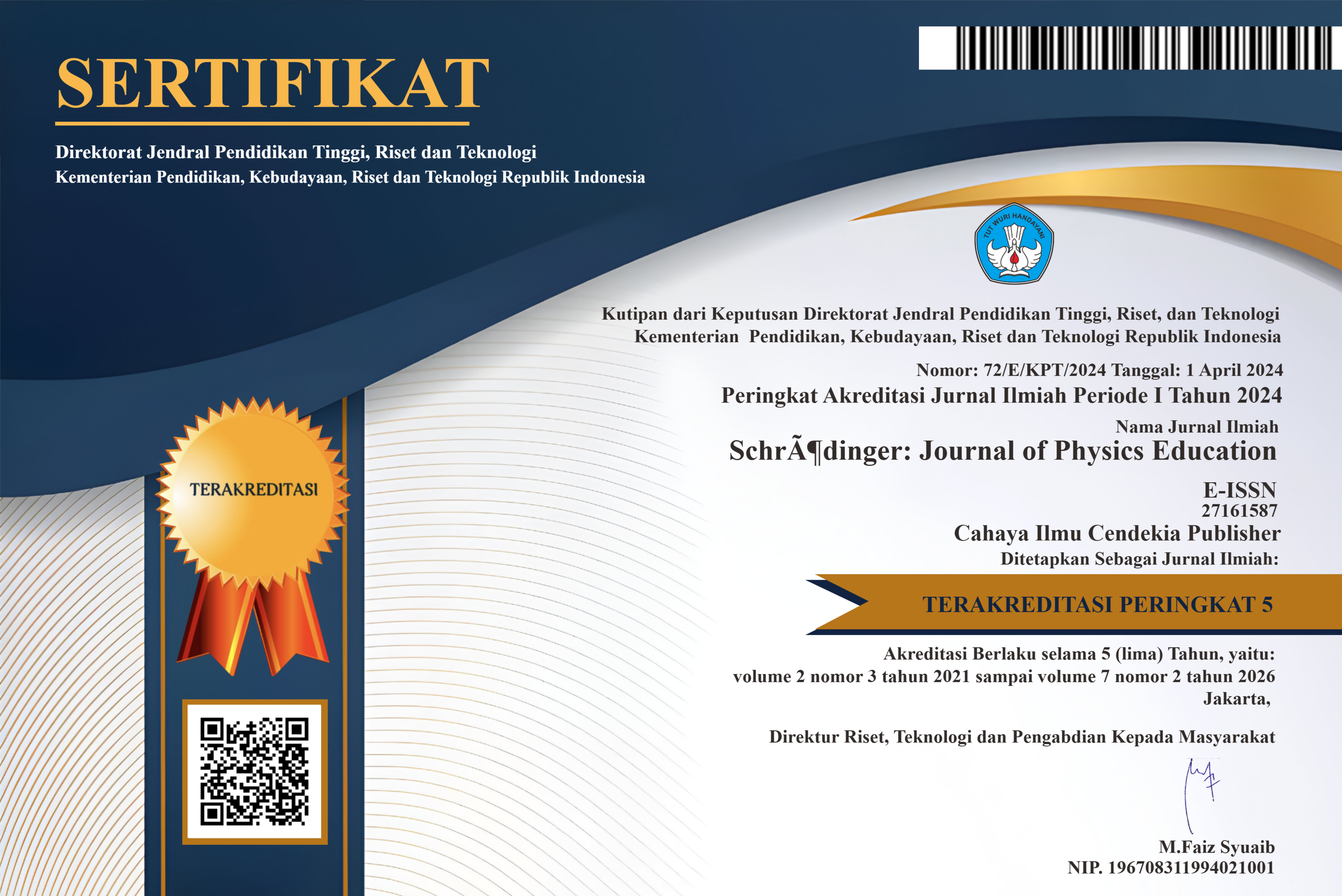The Effectiveness of the Reciprocal Teaching Learning Model Based on Multiple Intelligences (MI) on Student Learning Outcomes in Class VIII Vibration, Waves and Sound Material
Abstract
Purpose of the study: This study aims to determine the effectiveness of the reciprocal teaching learning model based on multiple intelligences on the learning outcomes of students on vibration, waves and sound in class VIII Junior high school.
Methodology: This research is experimental research conducted in junior high schools. The sample in this research was class VIII junior high school students. The sampling technique was carried out using a saturated sampling technique. Data collection uses the test method (multiple choice test) to obtain data about learning outcomes. Test the research hypothesis using the t-test.
Main Findings: Based on t test calculations with a significance level of 5%, tcount = 3.01 while ttable = 1.994. Because tcount > ttable means that the average physics learning outcomes of students who are taught using the multiple intelligence-based reciprocal teaching learning model are effective on student learning outcomes. So, it can be concluded that learning using the reciprocal teaching learning model based on multiple intelligences on vibration, wave and sound material is effective on the learning outcomes of class VIII students in junior high schools.
Novelty/Originality of this study: This research makes an important contribution in understanding how various learning strategies can be adapted to the individual needs and intelligence of students to improve their learning outcomes in complex material such as Waves, Vibrations and Sound.
References
A. Amin, D. A. Kurniawan, R. Perdana, W. A. Pratama, and E. Triani, “Analysis of the Relationship of Religious Character , Perseverance and Learning Motivation of Junior High School Students,” J. Innov. Educ. Cult. Res., vol. 3, no. 4, pp. 536–547, 2022, doi: 10.46843/jiecr.v3i4.233.
R. Kasperski and I. Blau, “Social capital in high-schools : teacher-student relationships within an online social network and their association with in-class interactions and learning,” Interact. Learn. Environ., vol. 0, no. 0, pp. 1–17, 2020, doi: 10.1080/10494820.2020.1815220.
R. Fitriani, L. Anatri, O. S. Joint, and R. Risnita, “Scope of Learning Evaluation in Science Subject in Junior High School Students: A Systematic Review,” J. Eval. Educ., vol. 4, no. 1, pp. 08–16, 2023, doi: 10.37251/jee.v4i1.307.
I. Ngkoti, “Expression of Students’ Elementary School on Planting Lesson,” J. Basic Educ. Res., vol. 2, no. 1, pp. 6–9, 2021, doi: https://doi.org/10.37251/jber.v2i1.112.
D. Ayim-Aboagye, “European Intelligence ’ From the Perspectives of Cognitive Psychology-Neurobiology : Why are the Europeans what they are Today ?,” J. Heal. Med. Sci., vol. 6, no. 2, pp. 48–62, 2023, doi: 10.31014/aior.1994.06.02.268.
A. Akbar, “Correlation Study of Student Learning Motivation in Civics Subjects in High School,” J. Soc. Knowl. Educ., vol. 4, no. 2, 2023, doi: 10.37251/jske.v4i2.428.
W. Astuti and M. H. Sianipar, “The Effect of Scaffolding Using the Peer Tutoring Method on Biology Learning Outcomes in the Material of the Human Excretory System,” Indones. J. Educ. Res., vol. 4, no. 2, pp. 43–48, 2023, doi: 10.37251/ijoer.v4i2.582.
A. Tamblyn et al., “How do physical or sensory early childhood education and care environment factors affect children ’ s social and emotional development ? A systematic scoping review,” Educ. Res. Rev., vol. 41, no. August, p. 100555, 2023, doi: 10.1016/j.edurev.2023.100555.
M. M. E. I. Bali and M. Musrifah, “The Problems of Application of Online Learning in the Affective and Psychomotor Domains During the Covid-19 Pandemic,” J. Pendidik. Agama Islam, vol. 17, no. 2, pp. 137–154, 2020, doi: 10.14421/jpai.2020.172-03.
A. N. Fauziyah, M. Ramadan, P. R. Gumede, and I. N. Udosen, “Development of Physics Learning Media Using Kvisoft Flipbook : Bilingual Digital Books,” J. Educ. Technol. Learn. Creat., vol. 1, no. 1, pp. 7–15, 2023, doi: 10.37251/jetlc.v1i1.618.
M. Widiyasanti and Y. Ayriza, “Pengembangan Media Video Animasi untuk Meningkatkan Motivasi Belajar dan Karakter Tanggung Jawab Siswa Kelas V,” J. Pendidik. Karakter, vol. 9, no. 1, pp. 1–16, 2018, doi: 10.21831/jpk.v8i1.21489.
H. Sabil, D. A. Kurniawan, R. Perdana, F. I. Putri, and S. E. Septi, “The Influence of Tarompa E-Module on Peace-Loving Characters,” vol. 12, no. 2, pp. 283–292, 2023.
Y. F. Narut and K. Supradi, “Literasi sains peserta didik dalam pembelajaran ipa di indonesia,” J. Inov. Pendidik. Dasar, vol. 3, no. 1, pp. 61–69, 2019.
T. Tanti, D. A. Kurniawan, R. P. Wirman, R. W. Dari, and E. Yuhanis, “Description of student science process skills on temperature and heat practicum,” J. Penelit. dan Eval. Pendidik., vol. 24, no. 1, pp. 88–101, 2020.
D. D. Romadona, “A Study of Science Process Skills on Simple Pendulum Materials,” SchrödingerJournal Phys. Educ., vol. 4, no. 1, 2023, doi: 10.37251/sjpe.v4i1.494.
W. T. Wulandari, “Contextual Learning Approach : Development of Worksheet in Physics Subjects,” Schrödinger J. Phys. Educ., vol. 4, no. 2, 2023, doi: 10.37251/sjpe.v4i2.506.
M. Fidan and M. Tuncel, “Developing a self-efficacy scale toward physics subjects for lower-secondary school students,” J. Balt. Sci. Educ., vol. 20, no. 1, pp. 38–49, 2021, doi: 10.33225/jbse/21.20.38.
N. A. Pambudi and B. Harjanto, “Children and Youth Services Review Vocational education in Indonesia : History , development , opportunities , and challenges,” Child. Youth Serv. Rev., vol. 115, no. May, p. 105092, 2020, doi: 10.1016/j.childyouth.2020.105092.
Y. Yulisa, L. Hakim, and L. Lia, “Pengaruh Video Pembelajaran Fisika Terhadap Pemahaman Konsep Siswa Smp,” J. Lumin. Ris. Ilm. Pendidik. Fis., vol. 1, no. 1, p. 37, 2020, doi: 10.31851/luminous.v1i1.3445.
A. R. Sibilana, “Pendidikan Karakter Melalui Pembelajaran Berbasis Multiple Intelligences Di Markaz Arabiyah Pare Kediri,” Indones. J. Islam. Educ. Stud., vol. 3, no. 1, pp. 48–62, 2020.
M. Chatib, Gurunya Manusia. Bandung: Kaifa, 2011.
P. Suparno, Metodologi Pembelajaran Fisika Kontruktif dan Menyenangkan. Yogyakarta: Kanisius, 2004.
E. Legowo, “Model Pembelajaran Berbasis Penstimulasian Multiple Intelligences Siswa,” J. Kaji. Bimbing. dan Konseling, vol. 2, no. 1, pp. 1–8, 2017.
N. Faidah, R. Masykur, S. Andriani, and L. Herlina, “Realistic Mathematics Education ( Rme ) Sebagai Sebuah Pendekatan Pada Pengembangan Modul Matematika Berbasis Teori Multiple Intelligences Realistic Mathematics Education ( Rme ) As An Approach To Development Of Mathematical Module Based On Multiple Intel,” Indones. J. Sci. Math. Educ., vol. 02, no. 3, pp. 328–332, 2019.
F. Lutfiyah and D. K. Wardani, “Relevansi Teori Multiple Intelligences Dengan Pendidikan Agama Islam Menurut Zakiah Daradjat di RA ‘Terpadu” Pojok Klitih Plandaan Jombang,” J. Educ. Manag. Stud., vol. 2, no. 6, 2019.
F. A. Candra, D. Setiawan, and A. Yus, “The Effect Of Problem Based Learning Model Through Home Visits And Learning Motivation On Pipkin Learning Outcomes Of Class Iv Students Of Upt Spf Sdn 106828 Sumberjo,” Int. J. Educ. Linguist., vol. 2, no. 1, 2022.
F. D. Widayanti, “Penerapan Strategi Pembelajaran Reciprocal Teaching Dengan Memperhatikan Multiple Intelligences Mahasiswa Untuk Meningkatkan Kualitas Pembelajaran Pembelajaran,” Erud. ( J. Educ. Innov., vol. 3, no. 3, pp. 37–54, 2017.
A. Gandasari, D. Wahyudin, I. Abdulhak, and A. Djohar, “The national curriculum implementation into the operational curriculum based on multiple intelligences theory ( Research dissemination before pandemic Covid-19 ),” Indones. J. Soc., vol. 14, no. 01, pp. 14–25, 2022, doi: 10.20473/ijss.v14i1.33003.
L. Ndia, E. Solihatin, and Z. Syahrial, “The Effect of Learning Models and Multiple Intelligences on Mathematics Achievement,” Int. J. Instr., vol. 13, no. 2, pp. 285–302, 2020.
M. P. Nugroho and Suyoso, “Pengaruh Penggunaan Model Reciprocal Teaching Pada Pembelajaran Fisika Terhadap Peningkatan Motivasi Dan Hasil Belajar,” no. 2, 2018.
Djaali, Metodologi Penelitian Kuantitatif. Jakarta Timur: PT. Bumi Aksara, 2020.
S. Riyanto and A. A. Hatmawan, Metode Riset Penelitian Kuantitatif Penelitian Di Bidang Manajemen, Teknik, Pendidikan Dan Eksperimen. Yogyakarta: Deepublish, 2020.
A. Q. Sari, Y. L. Sukestiyarno, and A. Agoestanto, “Batasan Prasyarat Uji Normalitas Dan Uji Homogenitas Pada Model Regresi Linear,” Unnes J. Math., vol. 6, no. 2, pp. 168–177, 2017.
A. Winarti, L. Yuanita, and M. Nur, “The effectiveness of multiple intelligences based teaching strategy in enhancing the multiple intelligences and Science Process Skills of junior high school students,” J. Technol. Sci. Educ., vol. 9, no. 2, pp. 122–135, 2019, doi: 10.3926/jotse.404.
Copyright (c) 2023 Lailatus Saida, Jana Raganova, Ali Auta

This work is licensed under a Creative Commons Attribution-NonCommercial 4.0 International License.
Authors who publish with this journal agree to the following terms:
- Authors retain copyright and acknowledge that the Schrödinger: Journal of Physics Education is the first publisher licensed under a Creative Commons Attribution 4.0 International License.
- Authors are able to enter into separate, additional contractual arrangements for the non-exclusive distribution of the journal's published version of the work (e.g., post it to an institutional repository or publish it in a book), with an acknowledgment of its initial publication in this journal.
- Authors are permitted and encouraged to post their work online (e.g., in institutional repositories or on their website) prior to and during the submission process, as it can lead to productive exchanges and earlier and greater citation of published work.






.png)
.png)








.png)
.png)
.png)







